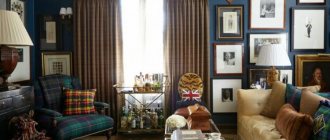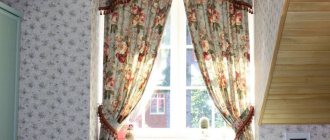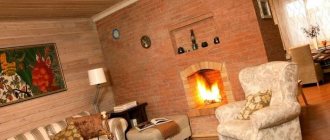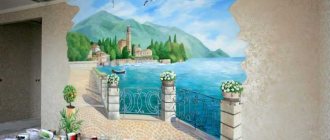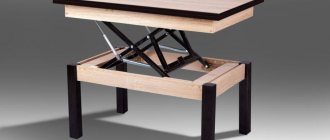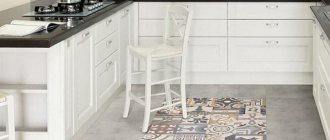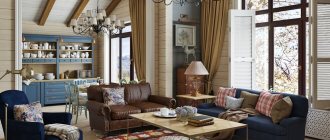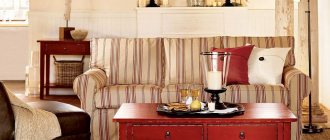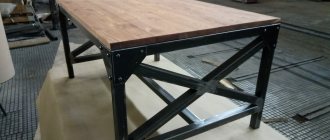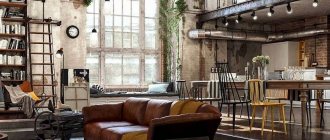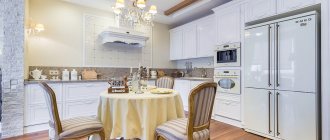Since the end of the last century, the rustic style has become very popular in the interior design of country houses and dachas. This is both a brutal and homely solution for arranging a living space.
It is based on rustic roughness and the aesthetics of natural materials. An eclectic combination of modern household appliances and elements taken from pristine nature create a unique atmosphere of freedom from fashion and trends.
But the style is not as simple as it seems at first glance. A couple of errors in design and all the work can be safely multiplied by zero. Let's figure out the nuances together.
Style Features
Rustic style is a type of country interior design. This mixed style combines eco-friendliness and old-time rustic aesthetics. Rustic is a very popular style solution for country houses.
- The main distinguishing feature is eclecticism. The interior harmoniously combines modern technology, comfortable furnishings, original accessories and simple decoration.
- The main elements of the style are natural materials such as stone and wood.
- The pieces of furniture have a solid, massive and slightly rough appearance.
- The interior contains homespun fabrics and natural fabrics in natural colors or with ethnic patterns.
The photo shows the design of a dining room made in a rustic style.
What can you combine the rustic style with?
The brutality of the style can be softened by combining wall decoration with different materials in the same color scheme. You can also carefully leave some decorative items - photographs in frames (not as rough as other interior items). Small bouquets of dried flowers are hung on the walls.
Decoration in design Source postroika.biz
Against the background of massive and rough furniture, textiles in light shades, light covers on chairs and linen curtains on the windows, and blankets made in patchwork style look good.
Finishes and materials
The cladding is carried out mainly in natural and high-quality materials.
- Floor. To finish the floor in a rustic style, different wood species are used in the form of bleached, stained oak, wenge, birch, pine, alder or linden. The materials undergo minimal processing, so they have natural defects, knots and cracks. Linoleum or laminate with an imitation of wood that has darkened over time would also be appropriate on the floor.
- Walls. Rough stone or red brickwork look quite voluminous and give the interior an antique look. In a small room in a rustic style, the walls can be decorated with decorative plaster, liquid or paper wallpaper with a rough texture. Casually applied paint will also work.
- Ceiling. The surface is painted, whitewashed or wallpaper with a wood texture is used. Massive beams with bark remnants accentuate the rustic style especially well.
- Doors. Wood is used in the manufacture of structures. Rustic doors should have a fairly solid and reliable appearance.
- Window. When finishing a house, it is preferable to choose frames made of natural wood. Laminated PVC windows, stylized to match the surrounding design, would be appropriate for apartments.
The photo shows a living room with a stone wall and a ceiling decorated with wooden beams.
For rooms with high levels of humidity, cladding in the form of tiles imitating iron or wood is generally chosen.
The photo shows a rustic-style living room with a laminate floor.
Tips for choosing
When choosing linen curtains, you should listen to the advice of professional designers and ordinary people who “ate the dog” when decorating their homes:
- Linen goes great with cotton. Natural fabrics form an original multi-textured combination.
- To prevent curtains from wrinkling so much, you should choose linen fabric with the addition of viscose.
- Linen fabric, richly decorated with lace, is suitable only for ethnic trends. It looks outdated and is associated with typical interiors.
- Rough texture looks best on thin fabric. Translucent linen curtains are a must-have attribute of marine and Scandinavian styles.
- For the bedroom you cannot choose a material that imitates natural linen. If the composition contains synthetic fibers, then this will negatively affect the ability of the fabric to “breathe” and its environmental friendliness.
- If the curtains are decorated with a pattern, then it must echo the pattern on the upholstery or wallpaper.
- For country style, choose simple burlap curtains, which are decorated with openwork garters. This decorative attribute is easy to make with your own hands.
Sources
- https://roomester.ru/dekor/shtory/lnyanye-shtory-v-interere.html
- https://design-homes.ru/idei-dlya-doma/lnyanye-shtory
- https://ars.ru/lnyanye-shtory-v-interere-foto/
- https://oshtorah.ru/shtory/shtory-izo-lna-v-interere.html
- https://textiletrend.ru/shtoryi-gardinyi/gostinaya-sht/lnyanyie-shtoryi.html
Colors
Rusticism is characterized by soft woody, earthy or sandy tones, diluted with milky or white tones. Accents in the room can be created using grassy, green, blue or muted red shades.
For rustic, choose natural colors, including a maximum of 2-3 shades. The interior of the room perfectly combines beige and terracotta, light yellow and burgundy, brown and canvas, olive and gray or brass and anthracite colors.
Color palette
Rustic style completely excludes the use of bright colors, unnatural textures and shades. The gamma is created using the following colors:
- all shades of wood (wenge, cherry, bleached oak, ash, alder, etc.);
- sand;
- dry herbs:
- all shades of stone;
- earth and clay.
When using wood, it is not recommended to paint it or shade it with unnatural colors. It is permissible to change the color using stain, and cover the surfaces only with varnish.
Furniture
In a rustic style, furniture items combine natural elegance and a certain amount of brutality. Oak, cherry, pine or beech are used to make elements. The furniture is mostly light or dark brown, complemented by scratches, unevenness, cracks and other imperfections.
The photo shows a bed with a frame made of natural untreated wood in a rustic bedroom interior.
Current furniture is a massive dining table with stools, chairs or rustic benches. The rustic interior is also furnished with armchairs and beds with log frames, open shelves and wooden cabinets.
Lighting
As a stylish accessory, you can install a wooden side lamp or hang an original chandelier made of branches or deer antlers. No less relevant are built-in spotlights.
For rustic, stylized lighting fixtures are selected in the form of kerosene lamps, lamps with long cords or forged candelabra. It is appropriate to decorate the decor with a floor lamp with a carved leg or table lamps with beautiful lampshades made of twigs, roots or vines.
The photo shows a rustic style bedroom with a round ceiling chandelier made of metal.
The spacious room is decorated with a massive central chandelier on a long mounting device. If the ceiling height is sufficient, you can install a church lamp with a large number of light bulbs or candles.
The photo shows kitchen lighting in a rustic style in the interior of a country house.
Curtains and other textiles
Textile elements allow you to emphasize the rural flavor and add extra charm and comfort to the interior. To decorate a room, a variety of products are used in the form of curtains, pillows, furniture covers, carpet runners, knitted blankets and bedspreads using the patchwork technique.
The photo shows a rustic-style bedroom with a window decorated with thick checkered curtains.
For windows in a rustic-style apartment or house, choose curtains made from natural cotton, linen, wool or silk fabric. Blinds made from reeds or straw would also be appropriate.
The floor in the interior can be decorated with a reed mat, a woven or braided carpet, as well as animal skin or its imitation.
The photo shows textile decoration of an attic bedroom in a rustic style.
Origin story
Many consider the rustic style to be a type of country or Provence. It is believed that this trend came to cities from villages, but the situation was a little different. People bought old houses for relatively big money, but not everyone could afford a full-fledged “urban” renovation, and therefore the main details were left as is. This was the case in the West, in the USA, but in Russia many elements of the style resemble the decoration of the original Russian interior of the beginning of the last century.
This style is suitable for those who are tired of the abundance of plastic, metals, and glass in modern design. Rustic design involves the use of natural, mostly unprocessed materials that have retained their natural shape.
The style has many volumetric details, which is why it is preferable to use it in spacious, bright apartments and private houses.
Decor and accessories
Objects in the form of wicker baskets, old chests, paintings depicting animals or forest landscapes will be an excellent decor. The decor can be supplemented with an armful of firewood or a coffee table made from an ordinary stump.
The most suitable for rusticism is the use of unglazed clay dishes, ceramic bells, wooden crafts and wicker panels.
The photo shows the interior of the living room with a firewood shed and white fur sofas.
It is also appropriate to decorate the design with mirrors in rough frames made of boards, ceramic plates, samovars, flowerpots, tubs and boxes with forged parts.
The photo shows the rustic interior design of a small living room in the house.
More warmth? Fireplace!
The fireplace is not just the semantic center of the room around which the composition is built. He is also responsible for the atmosphere.
Rustic is not about a universal interior. This is about an atmosphere that is not suitable for everyone. Before you decide on a wood-rich interior, try testing it on a country trip or vacation. Stay in such a house for a few days or maybe weeks. To understand whether you like textures and massiveness, or do you still want something lighter? The interior we dream about is not always the interior that suits us. So be careful!
Photos in the interior of the rooms
Design options for rooms for various functional purposes.
Kitchen
To decorate the walls in a rustic kitchen, wooden panels are often used, the ceiling is decorated with false beams, and parquet or brown tiles are laid on the floor. The room is furnished with a high-quality table, comfortable chairs with thick, stable legs, artificially aged cabinets and all kinds of hanging shelves made of natural wood.
The apron area can be laid with masonry or use tiles and panels with its imitation. It is better to hide household appliances behind the facades of the kitchen unit, and cover the refrigerator with a special film with a wood texture.
The photo shows a kitchen interior with an apron area lined with matte black tiles.
Various decor in the form of linen curtains and tablecloths, potholders and towels with ethnic patterns, lace napkins and cast iron cookware will help complete the kitchen interior design.
Bedroom
A large, strong and comfortable bed with a metal frame or a wooden base in the form of a woodpile is installed in the room. Near the bed there are bedside tables that have the most uncouth design. It would be appropriate to replace the chest of drawers with a voluminous chest with forged elements.
The photo shows a bedroom design with a wooden bed and a fur blanket, typical of the rustic style.
To zone the bedroom, you can choose a wooden partition or a wicker screen. For lighting, a wardrobe, a place with a dressing table or a work area are separately equipped with small lamps with wicker lampshades made of wicker.
Rustic in the living room
If possible, the living room is complemented with a fireplace. The portal is laid out with stone or decorated with tiles. The plank floor is decorated with carpets or animal skins, and a massive lamp suspended on chains is placed on the ceiling.
The photo shows the rustic interior of a small living room with a fireplace.
It is appropriate to equip the center of the room with a spacious sofa and armchairs, decorated with pillows or a blanket.
Bathroom
A bathroom with a basic stone or tile finish will look advantageous. Only the ceiling plane, door panels or cabinet can be made of wood.
The sink is mounted in an asymmetrical countertop made of thick logs. The mirror frame is decorated with pieces of real bark or its plastic and rubber imitation. A rustic bathtub is shaped mainly like a wooden tub or is made in the form of a thick brass bowl.
To create a more aesthetic interior, the bathroom is decorated with wicker baskets, ladders that act as hangers and sisal rugs.
Children's room design
The interior is equipped with wicker baskets for toys or open shelving is installed. The bed can be a single-tier or two-tier model in the form of a house with a ladder. It would also be appropriate to decorate a nursery in a rustic style with chests, stump chairs or rocking horses.
The photo shows a children's room for a boy with wooden walls and rustic decor.
Decoration of the hallway and corridor
The hallway and corridor can be decorated using ancient Russian vestibules with wooden walls, a ceiling and a floor lined with ceramic tiles or stone.
A wooden front door often has forged fittings and metal trims. Instead of a hanger, deer antlers are placed in the interior of the corridor, an ordinary bench and a small chest of drawers with a mirror in a massive frame are installed.
About flax: history, production and interesting facts
The discoverers of flax were the Indians.
Almost 10,000 years ago, linen was first made here. Gradually it replaced the “natural” material - animal skins. The plant began to be grown everywhere. Unique linen fabrics were woven in Ancient Egypt. Due to its incredible lightness, the fabric has been compared to “baby breath.” For clarity: 1 kg of yarn consisted of a thread approximately 240 km long. A modern ball of similar weight unwinds 30-40 km. The linen fabric turned out to be so thin and weightless that, folded in five layers, it was still slightly translucent. Any item of clothing could be passed through the ring. In Egypt, the loss of the harvest of this plant was considered a real disaster.
Linen items were highly valued in ancient times. The cost of the canvas was determined using scales. A thing was placed on one bowl, and gold according to its weight on the other. Only wealthy people, mainly priests, dressed in such clothes. Linen ribbons (bandages) were also used for mummification. They are perfectly preserved, as evidenced by the finds of Egyptologists. Some critics skeptically note that the bandages were soaked in balm, which “preserved” them, but linen fabric itself lasts a long time. It is believed that the secret of the “weightless” material has been irretrievably lost.
In Rome, linen was preferred by women. In Rus', plant cultivation began late - only at the beginning of the 11th century. The material was woven only for their own needs. Only by the middle of the 18th century did Catherine II give official permission to export fabric. In Europe, for a long time, linen was considered the preserve of wealthy families. Although the cost of fabric fell in comparison with Egyptian prices, it still remained high.
It was only after the Renaissance that even the poor could afford such things. Now flax is grown everywhere. In recent years, there has been a real boom in natural fabrics. Cotton, although lower in cost, clearly lost to flax in this competition. The point is the unique properties of hypoallergenic fabric, which is not only pleasant to the skin, but also treats burning, itching and other signs of irritation.
Special varieties of flax are used to make fabric. First, the plant is soaked, then dried and thoroughly crushed. The resulting blocks of raw flax are sent to the spinning mill, where they are made into threads.
Selection of houses
In the interior of country buildings, rustic looks especially harmonious. A solid and simple finish in the form of wide boards or lining fits perfectly into the design of a veranda at the dacha. You can choose wicker furniture or use forged items that look advantageous against the background of stone walls. Silk textiles with floral or plant patterns will help add air to the atmosphere and soften the rough color of the style.
The photo shows the design of an open country veranda in a rustic style.
The terrace is decorated in a monochrome gray-brown color scheme. Stone and wood are used in large quantities for finishing. The terrace is often equipped with a stove, barbecue or summer kitchen.
Different colors of linen curtains
Linen fabric for curtains has been used for centuries. One of its aesthetic advantages, which gives the curtains a unique charm and makes their design unique, is their natural color - natural, natural, but not monotonous. It is due to the characteristics of natural raw materials and has colors that are pleasing to the eye, close to natural tones: from blurry whitish to dark gray and light beige. Today, everything natural is in trend and such textiles are the most popular. But this does not mean that the wealth of choice is limited to natural, unprocessed colors.
The colors of linen curtains are:
- Made from unbleached linen. This textile is reminiscent of hand-woven fabric on an ancient loom and is distinguished by a coarse, clearly visible weave in gray or brown shades. It is ideal for antique-style “rustic” interiors.
- Made from bleached flax. The weave is not as coarse as that of unbleached textiles, and the shades of gray and brown are several shades lighter, ranging from medium rich to off-white. This color scheme gives the curtains a sophisticated and sophisticated touch and is suitable for a wide variety of interior styles.
- Made from colored linen. If desired, linen curtains can be dyed. But due to the high content of fatty and waxy substances and the structural features of the fibers, the color of the fabric turns out muted, as if washed out or slightly faded. It looks very stylish and, thanks to the richness of colors, such curtains are widely used in rooms for a wide variety of purposes: from residential interiors to commercial ones.
More vibrant colors are obtained using printed patterns (printing), appliqués or weaving with other types of threads. Both bright and delicate and elegant embroidery in light colors look great on linen.
On sale you can often find a large selection of so-called “linen-look curtains” made of 100% polyester, both natural and bright colors. They don't have most of the benefits of natural products, but they look almost the same and cost about half the price.
In order not to make a mistake with the composition of the fabric, its naturalness can be easily checked. You need to set fire to a small piece of it. If after it burns, only crumbly ash remains - natural flax.
